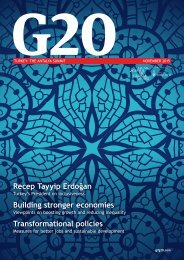SOURCE: Derivatives Special Report
SOURCE Derivatives Special Report provides expert analysis and information on the derivatives markets and provides insight into the large and complex challenges being faced by the global derivatives industry. SOURCE Derivatives Special Report strives to identify emerging risks and mitigation strategies, while covering the fascinating people who drive the industry forward. The magazine will be published in June and November 2015 and quarterly from 2016 with the launch of our website, sourcederivatives.com in September 2015. SOURCE Derivatives Special Report is the leading analytical publication on derivatives, providing a detailed study of theoretical models and how they are used in practice. SOURCE Derivatives Special Report gives you results-oriented analysis and statistical information on derivative products and techniques.
SOURCE Derivatives Special Report provides
expert analysis and information on the derivatives
markets and provides insight into the large and
complex challenges being faced by the global
derivatives industry.
SOURCE Derivatives Special Report strives to
identify emerging risks and mitigation strategies,
while covering the fascinating people who drive
the industry forward.
The magazine will be published in June and
November 2015 and quarterly from 2016 with
the launch of our website, sourcederivatives.com
in September 2015.
SOURCE Derivatives Special Report is the
leading analytical publication on derivatives,
providing a detailed study of theoretical models
and how they are used in practice.
SOURCE Derivatives Special Report gives you
results-oriented analysis and statistical information
on derivative products and techniques.
You also want an ePaper? Increase the reach of your titles
YUMPU automatically turns print PDFs into web optimized ePapers that Google loves.
Q&A<br />
Q & A<br />
Snakes and ladders<br />
Andrea More, managing director, Global Collateral Services at BNY Mellon,<br />
talks about the opportunities and challenges presented by regulatory change.<br />
Q: Can you elaborate on any negative<br />
implications that you foresee arising<br />
from EMIR? In particular, should we be<br />
worried about duplication?<br />
AM: There may be negative implications arising<br />
from how EMIR is structured and implemented.<br />
Given that mandatory central clearing<br />
will not apply to all OTC derivatives, firms<br />
may find themselves having to support dual or<br />
parallel legal arrangements and systems, one<br />
for OTC derivatives that are centrally cleared<br />
and the other for any non-cleared OTC derivative<br />
trades. Obviously there is a knock-on effect<br />
in terms of operational complexity and costs.<br />
However, it is also possible that the phased<br />
implementation of EMIR will mean sell-side<br />
firms having to manage three parallel systems<br />
– one to manage their legacy, pre-EMIR environment;<br />
then, as EMIR is implemented, they<br />
will be forced to develop additional systems to<br />
handle OTC derivative transactions eligible for<br />
central clearing; and then potentially another<br />
to manage their non-cleared OTC derivative<br />
transactions.<br />
26<br />
Q: Do you think EMIR offers any<br />
opportunities for fund managers and if<br />
so what are they?<br />
AM: The introduction of a central clearing<br />
obligation for eligible OTC derivatives means<br />
asset managers will benefit from the robust<br />
counterparty risk protection and default<br />
management procedures offered by a central<br />
counterparty (CCP), in addition to potential<br />
efficiencies in relation to risk-netting across<br />
those derivatives positions cleared via the CCP.<br />
These steps will enhance OTC market liquidity<br />
and may also offer efficiency improvements as<br />
a result of the standardisation of operational<br />
processes coupled with higher levels of transparency.<br />
Q: What do you see as the principal<br />
benefits of EMIR?<br />
AM: Enhanced safety and transparency are the<br />
goals of EMIR. EMIR requires that specified<br />
categories of OTC derivative contracts must be<br />
cleared via a central counterparty, while those<br />
OTC contracts that are not eligible for mandatory<br />
central clearing will need to meet new<br />
risk management standards in respect of timely<br />
trade confirmation, portfolio reconciliation,<br />
marking-to-market and marking-to-model,<br />
dispute resolution, collateral management and<br />
the level of capital required to cover exposures.<br />
It also establishes organisational, conduct of<br />
business and prudential standards for CCPs<br />
and trade repositories. Details of new OTC<br />
derivative contracts need to be recorded via a<br />
registered trade repository.<br />
Q: Do you think buy-side firms have<br />
generally prepared enough for EMIR?<br />
AM: If you go back months, firms had been<br />
running hard to ready themselves in line with<br />
the EMIR implementation timeline. However,<br />
the timetable was pushed back and aspects<br />
of the technical standards, and the ultimate<br />
design, of EMIR have still to be fully clarified.<br />
Consequently, some firms have been pushed<br />
into a holding pattern with their EMIR preparations,<br />
unable to commit to a final design until<br />
they have greater clarity around the technical<br />
and business requirements. For example, collateralisation<br />
requirements for bilateral OTC<br />
derivative transactions will adhere to guidelines<br />
mapped out in September 2013 by the Basel<br />
Committee on Banking Standards (BCBS) and<br />
IOSCO in their document “Margin Requirements<br />
for Non-Centrally Cleared <strong>Derivatives</strong>”.<br />
But the technical standards for collateralisation<br />
of bilateral OTC derivatives, based on these<br />
provisions, are not expected to come into force<br />
until December 2015.<br />
Q: What are the biggest changes that<br />
you expect to see for buy-side firms as a<br />
result of EMIR?<br />
AM: Mandatory central clearing obligations<br />
for eligible OTC derivatives may result in<br />
higher aggregate clearing and collateralisation<br />
costs once clearing fees, initial margin and<br />
variation margin requirements are factored<br />
in. Meanwhile the use of non-cleared OTC<br />
derivatives could become significantly more<br />
expensive. The ability of a buy-side firm to<br />
negotiate collateral margining terms with a<br />
counterpart may also be impinged upon in the<br />
CCP environment.<br />
Q: Will the implementation of EMIR<br />
prompt asset managers to revise how<br />
they utilise OTC derivatives in their<br />
trading and hedging strategies?<br />
AM: I think it’s true to say that there continues<br />
to be a debate within the industry regarding as<br />
to how the ramifications of EMIR in respect<br />
of both pricing and risk management will ultimately<br />
impact on the level of OTC derivative<br />
transactions. As you’ll recall, EMIR requires<br />
the collateralisation of non-cleared OTC<br />
derivatives. The requirement for buy-side firms<br />
to reconcile their bilateral OTC derivatives<br />
holdings with counterparties is a new obligation<br />
for many firms.<br />
Q: Where do we stand in terms of the<br />
current EMIR regulatory timetable, and<br />
what should we expect to see emerge in<br />
2015?<br />
DR_BYN Mellon Q&A.indd 26 20/10/2014 21:04
















